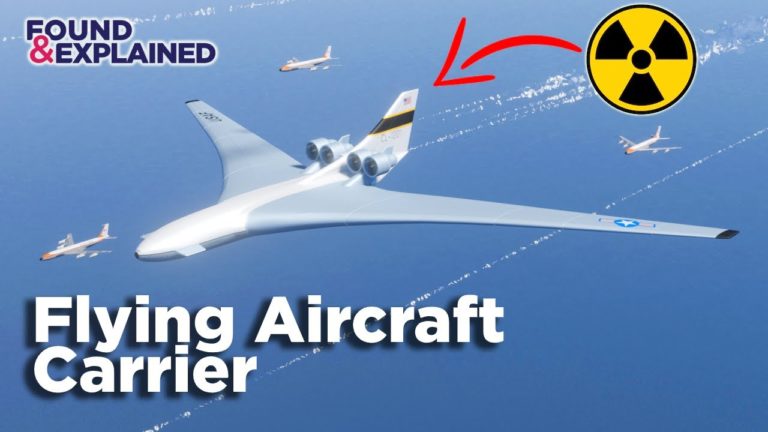The Nuclear Powered Flying Aircraft Attack Carrier – Never Built CL-1201
In 1969, Lockheed was tasked by the US air force to design a plane that was so big that it could carry 3000 troops, launch 22 parasite air to air jet fighters and fly for 41 days straight without landing. But it would never see the light of day, facing design challenges such as building a powerful enough nuclear reactor to how to even take off into the sky.
Designed by Lockheed to find the upper size limit of aircraft using conventional 1969 materials and technology – This is the CL-1201, the biggest aircraft never built.
The world of the late 60s was certainly an interesting one, America that faced enemies across the globe.
While the Boeing 747 that had just taken to flight was considered for the airforce, Lockheed was put onto the track to develop something even more gargantuan. A giant city-sized flying aircraft carrier.
The project would be dupped the CL-1201, based on the aerodynamic research for the previous CL-1170 – but with extensively increased dimensions.
The airframe would measure a wingspan of 1120 feet, and be 560 feet long, giving the fuselage an interior space of 2 million cubic feet.
For such a huge plane, conventional fuel wouldn’t cut it – this sucker would be nuclear powered, with the reactor system giving out a combined 1.83 gigawatts – allowing this plane to fly 41 days straight at Mach 0.8 over 16,000 feet, only having to land because the crew would run out of food and water. the crew of 475, who would be needed to maintain operations for 24/7. The reactor itself wouldn’t need to be refueled for over 1000 operation hours.
You see there was actually two versions of this plane. The CL-1201-1-1 and the CL-1201-1-3. there was technically also a mystery CL-1201-1-2 but all information about it has been scrubbed – but bare with me we will get to that model later.
The CL-1201-1-1 was dubbed the Attack Aircraft Carrier. It would carry eleven fighter bombers under each wing, and two more in the fuselage hangers, for a total of 24 aircraft. the documents they are listed as the F-4 Phantoms.
It would be the command center for any military operation. The plane would also carry ten long-range attack missiles, with Lockheed not ruling out that their warheads would be nuclear-tipped. This plane would never land in enemy land, simply circling the battlefield at 30,000 feet and around 600 miles away.
As for going deep behind enemy lines, that was up to the CL-1201-1-3, or dubbed, the logistic support aircraft or LSA.
This version of the plane would be the carrier for the bulk of the mission, bringing drop troops and other equipmentMITs, or converted Boeing 707s that would fly troops and materials back and forth from the LSA. The LSA would have a fleet of five 707 MITs that would physically dock three at a time to the LSA.
In addition to the 400 troops on the LSA, there would be 150 troops on each MIT, to a combined total of 1150 troops in the mini-fleet.
But these aircraft wouldn’t actually operate on their own. It would be a fleet group of a single attack aircraft carrier, and seven, Logisict support aircraft.
In total, the combined fleet would carry 3896 ground troops, 6207 tons of equipment, 30 days food and water, artillery, light aircraft and attack helicopters. Enough for a complete invasion of almost any country in the world.
While such an awesome projection of power would be invaluable for the surrounded United States, there were several major flaws with the design.
The aircraft wouldn’t take off from a runway at all. It would fly vertically like a Harrier jet. The LSA would use 54 recently developed turbojet engines from the Boeing 747 to provide over 82,000 pounds of thrust. The aircraft attack version would need a staggering 182 jets to provide vertical lift. Each engine would be in clusters of 20 throughout the plane.
But you might be asking why? If this plane was designed to fly from the continental United States to take on enemies abroad and never land, why give it the ability to land vertically at all?
Above 16,000 feet, the four massive turbojet engines, each with the diameter of a Boeing 747, would powerup with the tips going supersonic.
To power all of these engines, the CL-1201 would have a nuclear fission reactor that would provide 1.83 gigawatts for all operations onboard.
To prevent radioactive material from spilling out during a crash, the reactor was designed to be shut down within 20 seconds’ notice and could survive a head-on impact with a mountain traveling at 600 miles an hour.
Speaking of impact, the designers also realized that it would be susceptible to missile attacks – thus the solution was laser cannons and point defense systems to blow them out of the sky in flight.
In the end, the CL-1201 project didn’t get any further thanks to its cost, and what could have been has now faded into history.
Do not forget to share your opinion with us to provide you with the best posts !




0 Comments